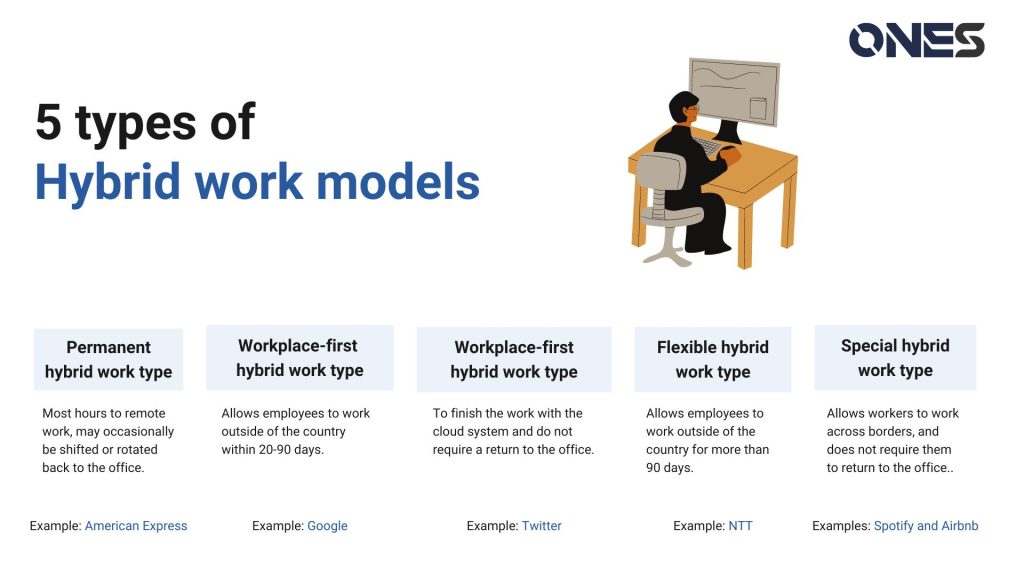Hybrid work is a new way of working that has gained popularity in recent years. This model combines the benefits of remote and in-person work, allowing employees to work from home or the office as they see fit.
In this guide, we will cover everything you need to know about the hybrid work model.
Table of Contents
What is hybrid working?

A hybrid work or a hybrid job is a flexible work arrangement that allows employees to work remotely and in-person. It combines the benefits of both work styles, giving employees more freedom and flexibility to work how they want.
The difference between hybrid and remote work is that hybrid work allows people to choose their own working style, while remote workforces employees to work in a fully remote position.
Why do workers need to go back to the office?
The followings are the reasons why people would need to go back to the office:
- Collaborate and work with colleagues: Employees can do better because they can collaborate to work with live dialogue.
- Immediate problem solving: In the office, there are lots of senior staff, and the junior can get instant help from the experienced, so ensuring the new workers work smoothly.
- Provides high-quality resources to support better work: In fact, employees need to have regular meetings to set strategies at work, and an office can provide a meeting room for them to have a better presentation with equipment, such as a projector and a professional monitor.
- Promote employees’ understanding of their company’s unique culture: The office provides a place for employees to meet. Through regular conversations with experienced employees, new hires can learn more about the company culture. This approach can help them adapt to their new environment and strengthen their sense of belonging.
- The best place for learning and improving skills: An office has many resources available to new employees to enhance their abilities, such as learning knowledge from experienced workers and studies from research reports.
What are the advantages of hybrid working?

Hybrid working is the best working model to combine the two sides’ opinions, provide both sides’ benefits, and provide workers with work in the office and remote work.
The benefits of the hybrid work model offer for both employees and employers, including:
- Increased flexibility and work-life balance for employees
- Reduced commute time and cost
- Greater productivity and job satisfaction
- Cost savings and increased talent pool for employers
5 types of hybrid work models
KPMG International Limited (KPMG) conducted research on hybrid work and published the report “Employer trends in the remote work world”. The aim is to help the directors measure the results of implementing the latest work mode and drive better tax outcomes for businesses and the workforce.

According to that report, hybrid work models can be divided into 5 types:
- Permanent hybrid work type: Domestic Remote Working
For most hours of remote work, some employees may occasionally be shifted or rotated back to the office. The main purpose of going back to the office is for training, regular meetings, or gatherings.
Example: American Express.
- Workplace-first hybrid work type: Cross-Border Short-Term Remote Working < 90 Days
This type of work means that employees can be abroad for a short period of time for travel/visiting relatives or other reasons within 20-90 days, they can also handle official business at the same time. At the other time, they should go back to the office.
Example: Google.
- Workplace-first hybrid work type: Virtual Assignments
This approach is most commonly used by people who work in the media or information. Employees might live far from the office/need long-term care at home, then use various virtual tools to conduct online meetings and collaborative work. They finish their work with the cloud system and do not require a return to the office.
Example: Twitter adopted this approach and will allow all employees to work from home.
- Flexible hybrid work type: Temporary Cross-Border Remote Working > 90 Days
This approach provides employees with sufficient flexibility in their work, and even allows employees to work outside of the country for more than 90 days. However, this is not a common practice.
Example: NTT does not require the employees to reside within commuting distance of the office and allows them to decide their work location by themselves. Moreover, NTT will allow employees to commute by plane if they are required to come to the office, and will even pay for their accommodation.
- Special hybrid work type: Hiring Talents in Another Country
Recruiting talents globally, allowing them to work across borders, and not requiring them to return to the office.
Example: Spotify and Airbnb.
To summarize, the common point is that these models are employee-oriented work styles.
The top priority of the styles is taking care of the well-being of employees, also building a culture based on inclusiveness, empathy, and trust. This is also one of the most important aspects of the hybrid effort.
How to implement hybrid work model?
Implementing a hybrid work model requires careful planning and communication. Here are some steps to follow:
- Define clear policies and guidelines for remote and in-person work
- Ensure employees have the necessary technology and equipment to work remotely
- Set up regular check-ins and meetings to stay connected with remote employees
- Monitor and measure performance to ensure the hybrid model is working effectively
Setups for employees
To help employees can easily collaborate with others everywhere, these tools are suitable for them:

Slack: It is a communication platform designed to help teams collaborate and provides a real-time dialog window. It also provides the free version to use, but only has a few functions.
Teams: The hub for team collaboration in Microsoft 365, integrates the people, content, and tools a team needs to be more engaged and effective.
Microsoft Viva: Powered by Microsoft 365 and it is an employee experience platform that brings together communications, knowledge, learning, resources, and insights in the flow of work.
Setups for admins

For the admins, the systems should help them take control of all the office equipment and services easily, like the hot desk, rooms, support & service functions, front-desk service, and IoT auto-release functions.
Hot desking: It provides a flexible working model for your office to adopt a hybrid workspace. Using hot desk booking can greatly reduce your office size, which can save operational costs.
Meeting Room Booking System: This software includes capabilities for managing, optimizing, and streamlining the meeting room booking process.
Support & service functions: Provide full support and service for your office that gives everyone a great smart office experience.
Front-desk service: It refers to the visitor management system. It can help your receptionists to reduce their workload and provides a streamlined visitor experience for your dear guests.
Internet of Things (IoT) functions: Supposed the IoT works with workplace hardware, the two items integrated could enable healthy space and occupancy management and provide a great employee experience.
Tips for successful hybrid work
To make the hybrid work model successful, consider the following tips:
- Establish clear communication channels and expectations
- Foster a culture of trust and autonomy
- Provide opportunities for team bonding and social interaction
- Prioritize mental health and well-being of all employees
Hybrid working: the best solution for the future workplace
Hybrid work model is a flexible and innovative way of working that can benefit both employees and employers. By following the steps and tips outlined in this guide, you can successfully implement this model in your workplace and enjoy the many benefits it offers.
Implementing hybrid work has lots of benefits for your company and employees, therefore lots of countries and places are implementing hybrid work. So, what are you waiting for?
Contact us for implementing your own hybrid working office:hello@ones.software, or visit ONES Software official website for more information: https://ones.software/.


